Initially part of the colony of New South Wales, between 1836 and 1851 Victoria was known as the District of Port Phillip. In 1851, the regions was declared the Colony of Victoria. After Federation in 1901, it became the State of Victoria. Today, Victoria is diverse and cosmopolitan. With evidence of human habitation in the region going back millennia, the contemporary community is made up of people from all over the world.
Research your ancestors on MyHeritage
Understand The History of VictoriaUnderstand The History of Victoria
Aboriginal Society in VictoriaAboriginal Society in Victoria
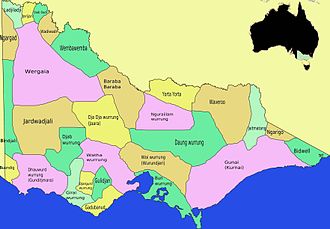
The area known today as the State of Victoria today is home to 38 Indigenous language groups[1]. There is archaeological evidence of human habitation going back over 40,000 years. Archeological sites such as Bidj Bide heritage area include ancient eel traps and other evidence of farming by the indigenous inhabitant.
Sacred to the Gunditjmara people, the Budj Bim National Heritage Landscape provides evidence of a system of channels and weirs constructed from the abundant local volcanic rock to manage water flows from nearby Lake Condah to exploit eels as a food source[2].
- The Dja Dja Wurrung people are the traditional custodians of the area around the watersheds of the Loddon and Avoca rivers in the Bendigo region.
- The Wurundjeri people are the traditional custodians of the lands around Melbourne and the surrounding areas.
- The Gunditjmara people are the traditional custodians of the south-western part of Victoria, including the Cape Otway region.
- The Yorta Yorta people are the traditional custodians of the area surrounding the junction of the Goulburn and Murray Rivers in north-central Victoria and southern New South Wales.
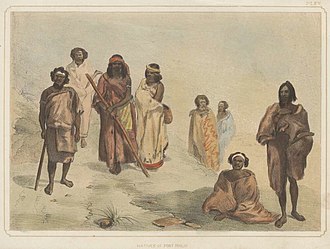
Australia's indigenous community does not have a written record repository before the colonial period so it is not possible to build traditional lineages in the same way as you can with other cultures. However as the aboriginal community have reclaimed their culture, they are rebuilding the orally transmitted records of their traditional language groups.
In 1839 Aboriginal people in the area around the Port Phillip colony came under the control of the Port Phillip Protectorate. George Augustus Robinson became the Chief Protector of Aborigines and four assistants were appointed to particular regions:
- William Thomas to the Melbourne and Westernport regions,
- James Dredge to the Goulburn region,
- Edward Stone Parker to the Loddon and Northwest District and
- Charles Sievwright to the Western District.
The Protectorate was largely unsuccessful and following a number of Select Committees the system was abolished[3].
In 1850 William Thomas was appointed Guardian of Aborigines for the Counties of Bourke, Mornington and Mount Evelyn. In 1860 the Governor of Victoria established the central Board to Watch Over the Interests of the Aborigines, to oversee the development of a system of Aboriginal reserves and depots throughout the colony and the passage of the powerful Aborigines Protection Act 1869[3].
PROV - Public Records of VictoriaPROV - Public Records of Victoria
PROV has a dedicated information page for Aboriginal genealogy. They also publish walata tyamateetj research guide - a guide to government records about Aboriginal people in Victoria. PROV holds many important records created during the operation of the Chief Protector of Aborigines (1838-1849) and the Guardian of Aborigines (1850-1860).
Koorie Name IndexesKoorie Name Indexes
The Koorie Index of Names (KIN) database can be searched to locate references to Victorian Aboriginal people mentioned in archival records that relate to Aboriginal affairs (1839-1946).
The KIN database is searchable on-site at the Victorian Archives Centre in North Melbourne or you can request a lookup by filling out the online enquiry form.
The National Archives of Australia holds the Bringing Them Home (BTH) Name Index, which covers Aboriginal Affairs in Victoria from 1860 to 1970. These files contain information about:
- people
- places
- events
- social welfare activities
- missions
- children’s institutions
- reserves, stations and settlements.
Access to these files is restricted so researchers must enquire directly via the online enquiry form. If library staff find the names you are looking for, you can ask for copies of records that mention the name or view the records in the research centre where they are held. For more information go to the NAA Website.
Both indexes are searchable by name, language group and date.
IATSIS - Australian Institute of Aboriginal and Torres Strait Islander StudiesIATSIS - Australian Institute of Aboriginal and Torres Strait Islander Studies
IATSIS plays a pivotal role in helping people with first nations heritage rediscover their family history. The IATSIS Family History Unit does not assist people to prove their Aboriginality. They do however provide assistance and resources for people researching their Aboriginal heritage.
European History of VictoriaEuropean History of Victoria
Although there was no direct transportation of convicts to Port Phillip, convicts were brought into the colony by various means at various times. David Collin's party, which settled at Sorrento in 1803, included some 300 male convicts… The contingent which settled at Western Port in 1826 in order to deter French interest in the region included convicts as well as soldiers, and convicts were assigned to the the Police Magistrate for the Port Phillip District, Captain William Lonsdale in order to carry out government work. Convicts were also assigned to the early surveyors to assist them in their work[4].
The first permanent European settlement in the area known today as Victoria was a whaling station established at Portland Bay in November 1834.
In 1835 John Batman signed two treaties with the local Aborigines to claim large tracts of land near modern day Melbourne and Geelong, but New South Wales Governor, Sir Richard Bourke, considered Batman's treaty invalid.
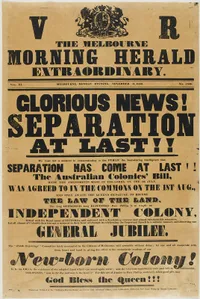
At the same time John Pascoe Fawkner set sail from Launceston in Tasmania aboard the schooner 'Enterprize'. Unfortunately he got horribly seasick and had to disembark before the boat crossed the Tasman Sea.
On 29 August,1835 the 'Enterprlze' sailed up the Yarra River and anchored at the site chosen earlier by Batman as "the place for a village". Fawkner's party then went ashore. landed stores and livestock, and proceeded to erect the settlement's first home. The 'Enterprize' then returned to Launceston to collect Fawkner and his family who eventually arrived at the settlement on I0th October 1835.[5]
Despite being considered trespassers by Governor Bourke, settlers moved onto the lush, fertile plains south of the Murray River. In January 1837, the Governor granted “squatters grazing rights beyond the "Limits of Location" subject to a £10 licence fee. In December that year plans for the settlement of Melbourne were approved and the first mail service between Sydney and Melbourne began[5].
Melbourne grew quickly and It wasn’t long before residents began to lobby for separation from NSW. At a Public meeting on 28 November, 1844 the separatists appointed a representative to take a petition to England.
On 5 August, 1850, the Australian Colonies Government Act received royal assent and the Colony of Victoria became a reality on July 1, 1851.
Understand Migration to VictoriaUnderstand Migration to Victoria
The Gold RushThe Gold Rush
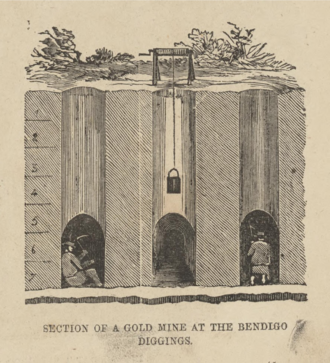
When gold was discovered in NSW in 1850, men in Port Phillip began to dessert the nascent colony. The newly formed government offered a reward of £200 to anyone who found gold within 200km of Melbourne. Within 6 months gold was discovered near Clunes, 40km north of Ballarat in central Victoria. It wasn’t long before the Victorian goldfields dwarfed those to the north, accounting for almost one third of the world’s gold production in the 1850s.[6]
Mt Alexander (taking in the goldfields of Castlemaine and Bendigo) was one of the world's richest shallow alluvial goldfields, yielding around four million ounces of gold, most of which was found in the first two years of the rush and within five metres of the surface.[7]
By 1871 the population of Australia had quadrupled. By the end of the 19th century, Victoria was a prosperous, diverse community.
The State Library of Victoria has a comprehensive guide to Gold Miners and Mining.
By the height of the gold rush an estimated 6000 miners were arriving in Victoria every week, with migrants coming from all over the world. Storekeepers, publicans and tradespeople also flocked to the fields to support the diggers and relieve them of their hard won wealth[8].
The largest non-European group of miners were Chinese, most of whom were bonded labourers who suffered discrimination from the government and fellow diggers. It’s estimated that by 1855 there were 20,000 Chinese on the Victorian diggings[9]. [But] …from 1855-61 ship's captains had to pay poll taxes of up to £10 per head for each Chinese passenger they landed in Victoria. Word soon spread back home, and many young Chinese seeking their fortunes subsequently disembarked in South Australia and walked overland to the Victorian goldfields.[10]
Eurkea StockadeEurkea Stockade
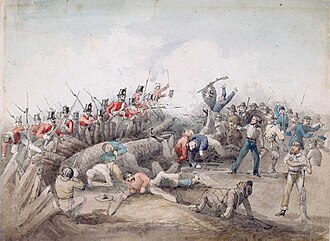
The influx of immigrants also brought new ideas. Members of the Chartist movement came, hoping for less restrictive government oversight. This heady mix of entrepreneurialism and political idealism eventually led to an event considered one of the defining moments of Australian democracy. Commonly known as the Eureka Stockade, this short lived miners rebellion, while initially a colossal failure, eventually led to innovations such as the secret ballot, an 8 hour working day and the Australian Labor Party.
‘Australian democracy was born at Eureka.’" Doc Evatt, former Leader of the Australian Labor Party and High Court judge,
Post-FederationPost-Federation
When the colonies federated to become the nation of Australia the seat of government was in Melbourne until Canberra was created to be the national capital. The National Archives of Australia office in Melbourne holds a large collection of records related to federal government activity from Federation in 1901, up until the 1960s. The collection holds many central administration records, including several related to immigration correspondence and case records, and shipping and navigation.
While most records date from Federation in 1901 onwards, they do have some records dating as far back as the 1850s, which were inherited from the Victorian colonial government. The MyHeritage Catalog holds the index for Australia, British Assisted Passengers to Victoria.
Major Archival SourcesMajor Archival Sources
PROV - Public Records Office Victoria, holds:
The State Library of Victoria has a large collection of research guides, to help you navigate their enormous collection.
Trove, managed by the National Library of Australia, is an extraordinary free resource that aggregates content, including digitised newspapers, magazines, images, diaries and letters, and other material, dating from the establishment of the colony, from collections around Australia.
The Immigration Museum, located in the old Customs House building on the banks of the Yarra River, charts the history and social impact of immigration to Victoria and showcases the stories of the state’s diverse communities.
Other ArchivesOther Archives
Military Archives from around the country are predominantly held at the Australian War Memorial (AWM). The collection includes millions of items relating to individuals, units and conflicts, including service records. Digitised service records for all Australians who served in WWI are available through the National Archives of Australia.
In regional areas and small country towns, local history and genealogical societies are a great source of local records. Many regional towns in Victoria have a local history society, and/or a local library and museum. The Federation of Australian Historical Societies has a searchable index where you can find contact details for a society in a specific town or locality, or simply do a web search for the town name plus historical society.
Births, Marriages & DeathsBirths, Marriages & Deaths
The Registry of Births, Deaths and Marriages Victoria website has an information page and searchable historical index of births, baptisms, marriages, burials and deaths dating back to as early as 1836. As per Australia’s national privacy legislation records are restricted to:
- births after 100 years,
- marriages after 60 years and
- deaths after 30 years.
You can order PDF or hard copy certificates directly through the website.
Rolls, Gazettes & DirectoriesRolls, Gazettes & Directories
Australian Electoral RollsAustralian Electoral Rolls
Australian census records have largely been destroyed and so are not available to family history researchers. The next best thing are Australian Electoral Rolls. Individuals registered to vote are listed in the rolls with their residential address and profession. MyHeritage holds a selection of Electoral Roll data.
Victorian Government Gazette (1859-1891)Victorian Government Gazette (1859-1891)
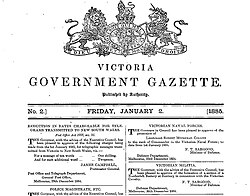
Government Gazettes hold information about licenses and legislation and often include the names of individuals in relation to regulated government activity such as licenses and permits. They can be an interesting supplementary source for genealogical research. MyHeritage holds a selection of Victorian Government Gazettes and they can also be accessed via Trove.
MyHeritage also holds records from the Victorian Police Gazette which records the names and charges against those arrested by Victorian Police.
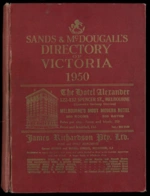
DirectoriesDirectories
MyHeritage holds a selection of Wise and Sands & McDougalls Directories for Victoria in their catalog. They can also be accessed online at PROV The Wise Victorian Post Office Directory contains a towns directory, an alphabetical directory, Melbourne, Ballarat, Bendigo and Geelong street directories, a Victorian trades directory and several miscellaneous directories. Sands is a huge directory consisting of over 1900 pages covering not only Melbourne, but also suburbs and the country areas too.
Research your ancestors on MyHeritage
Explore more about Victorian family history recordsExplore more about Victorian family history records
Webinars at Family Tree Webinars:Webinars at Family Tree Webinars:
References
- ↑ ANTaR Victoria - local nations
- ↑ Department of Climate Change, Energy, the Environment and Water - budj-bim
- ↑ 3.0 3.1 PROV - Aboriginal Protectorate and Guardian of Aborigines records
- ↑ State Library of Victoria Guide - Convicts
- ↑ 5.0 5.1 State Library of Victoria - Timeline
- ↑ [1]State Library of Victoria - Ergo - Golden Victoria
- ↑ Visit Melbourne - Gold Rush History
- ↑ https://resources.vic.gov.au/geology-exploration/minerals/metals/gold/gold-mining-in-victoria
- ↑ National Museum of Australia - Gold Rushes
- ↑ Museum Victoria - Immigration Museum

